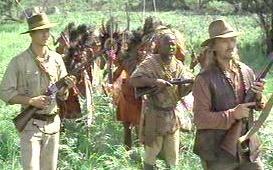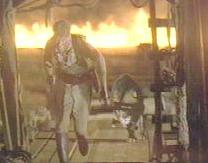
Whenever a film is shot on location, certain difficulties are bound to arise but when the movie is THE GHOST AND THE DARKNESS and the location in question is Africa, then the complications are magnified a thousandfold. In spite of the hazards of making a movie in such a remote area, the filmmakers still wisely decided to go to Africa in order to more accurately capture the circumstances and conditions surrounding those most unusual events that occurred in East Africa in 1898.
The first challenge was to find a location that would meet all the physical requirements of an actual railroad camp circa the turn of the century. It was essential that the area be situated on a large plain with a river flowing through it. In all of Africa, only one spot met all the criteria: the Songimvelo Game Reserve in Mpumalanga Province on the border between South Africa and Swaziland. Approximately two years of preparatory work went into getting the stage set for the remarkable events to follow. Authenticity was mandatory so excruciating pains were taken to ensure that the setting appeared as realistic as possible. As the movie's director, Stephen Hopkins, explains, "The hospital should be further away from the camp because no one wanted to be near the sick. And then there was the grass; how far does it have to go back so the lions have room to attack?" (1)
 Patterson & Mahina oversea the contruction of the bridge |
Once the camp was completely erected and filming began, Africa found ways to complicate matters even further. When this location had originally been scouted, climactic conditions were very dry and there had been some initial concern regarding how to film a movie about the building of a bridge over an area with so little water. In actuality, the absolute opposite end of the spectrum reared its head and the cast and crew of THE GHOST AND THE DARKNESS were forced to cope with unprecedented amounts of rainfall. Val Kilmer describes, "It started raining which it wasn't supposed to be doing. Then it rained more than it ever rained in five years and then Africa washed away our bridge to get to work so I had to take rafts and walk across the river and then it washed the bridge out again and again. And then it threatened to wash away the whole movie set bridge. A lot of hardships with the weather changing." (2)
A wonderful addition to the authentic flavor of this movie was the use of real Samburu warriors as extras. The Samburu live in the rugged Northern Frontier District of East Africa and most of them still choose to keep to the traditions of their ancestors in living in remote areas. To this day, it is still mandatory that each warrior kill a lion before becoming an official adult member of the tribe. None of these natives had so much as ever seen a movie in their life and now they were participating in one. Val Kilmer details, "There's a lot of power that you see in the faces of the people. There's a lot of laughter too because movie sets are always a surreal experience but imagine never having seen a film and being an extra on this and we've got a bridge halfway built and we keep pretending to build it but we don't really build it." (2)
Using the Samburu as movie extras did entail some special arrangements so as not to disturb their normal routines any more than was necessary. For example, the Samburu diet normally consists of milk, blood, porridge and meat so these items had to be provided on a regular basis in order to maintain their traditions. When plans were made to shoot a scene involving these warriors in a staged lion hunt, they first performed their own traditional private ceremony as a preparation for the hunt. Any and all pains that were taken to accommodate the Samburu were certainly more than worth the effort as, not only did their very presence add greatly to the overall authentic feel of the film but they also were responsible for a valuable contribution to the movie's soundtrack. Their chants and hunting songs were used extensively during the film to provide a stirring backdrop for the unfolding events.
 As one might assume, one of the most crucial elements of making this film was to find the animal actors to play the title roles. An extensive worldwide search was conducted and eventually six lions - two from Canada, two from France and two from Hollywood - were chosen to portray the two infamous man-eaters. Unfortunately an event occurred during the early stages of filming which necessitated cutting that number to five. Michael Hackenberger, one of the lion trainers associated with the movie, remembers, "We had a close call one day. We took six lions to Africa, and one attacked one of the actors and dragged him off. But we were able to get him off, then sent him (the lion) home." (3) Thankfully the actor in question was unharmed, the offending lion was returned to Hollywood and the rest of the production was incident free as far as the lions were concerned.
As one might assume, one of the most crucial elements of making this film was to find the animal actors to play the title roles. An extensive worldwide search was conducted and eventually six lions - two from Canada, two from France and two from Hollywood - were chosen to portray the two infamous man-eaters. Unfortunately an event occurred during the early stages of filming which necessitated cutting that number to five. Michael Hackenberger, one of the lion trainers associated with the movie, remembers, "We had a close call one day. We took six lions to Africa, and one attacked one of the actors and dragged him off. But we were able to get him off, then sent him (the lion) home." (3) Thankfully the actor in question was unharmed, the offending lion was returned to Hollywood and the rest of the production was incident free as far as the lions were concerned.
Because of the intensity required in some of the lion scenes, Hackenberger had originally suggested the use of some animatronic movie magic to enhance the action and lighten the burden on the lions, particularly in the case of the staged hospital wholesale slaughter. Hackenberger explains, "That was tricky. At one point, they brought in Stan Winston (the technical wizard responsible for the impressive audio-animatronic dinosaurs in JURASSIC PARK). But it was a disaster. They spent a fortune and only one shot was used. You must remember that it is easier to create dinosaurs; no one has ever seen one, so we have no point of reference. With lions, it's different, it doesn't work." (3) The decision was then made to go solely with live lion action which certainly resulted in an impressive finished product but also put special demands on the trainers. Hackenberger elaborates, "We were really pushing the envelope with what the lions had to do, but in the end we got a lot more work, and the French trainers were exceptional, so we were able to pull it off. But it was tricky. There were moments when we had to say, 'Okay guys, we've got to wrap for half an hour, 'cause these lions are just too warm right now; someone is going to get hurt.'" (3)
 For safety reasons, blue screen technology had to be used to superimpose two separate images: one of Val and the other Bongo the lion, making it appear that they are together in the same shot thereby adding realism to the scene. For safety reasons, blue screen technology had to be used to superimpose two separate images: one of Val and the other Bongo the lion, making it appear that they are together in the same shot thereby adding realism to the scene. |
All the unique steps the filmmakers took to bring the story of THE GHOST AND THE DARKNESS to life may have caused untold difficulties but the end result was well worth the effort. We, the moviegoers, were treated to a finished product that boggled the mind with its realism and stunned the senses with its overwhelming beauty.
References:
- THE GHOST AND THE DARKNESS press kit
- HBO Special - THE MAKING OF THE GHOST AND THE DARKNESS
- The Toronto Star